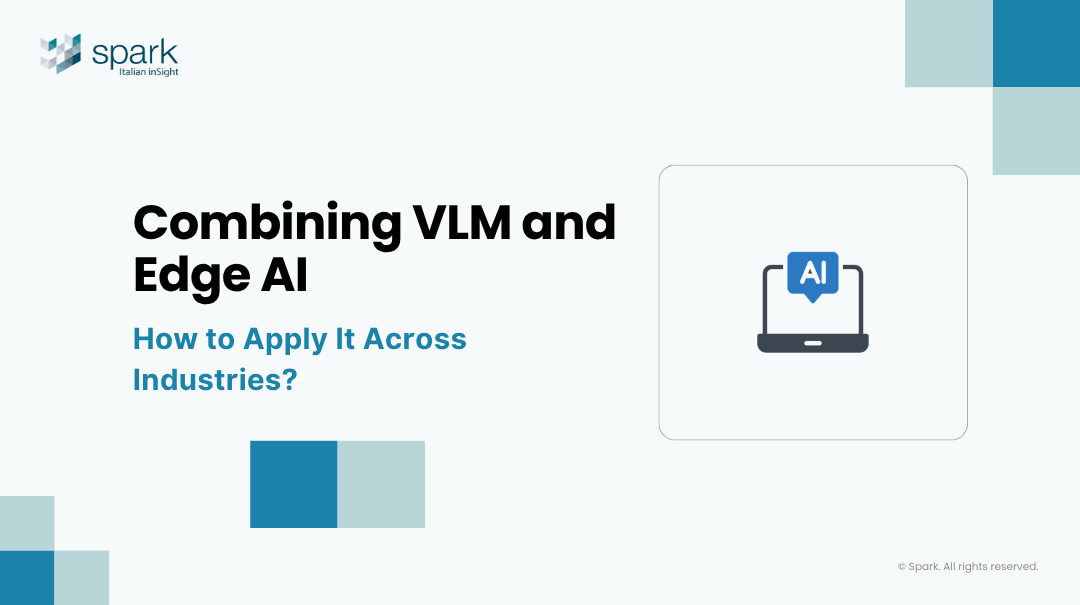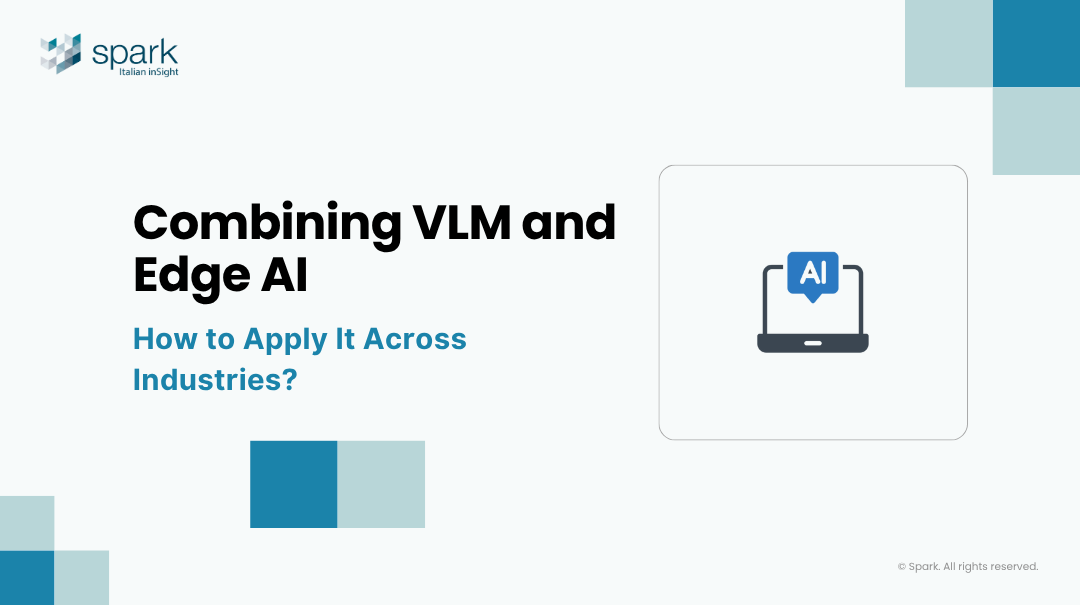2025.10.13
As artificial intelligence continues to evolve, multimodal AI has become a core trend in both research and industrial applications. Among these innovations, the Vision-Language Model (VLM) stands out by enabling machines to understand both what they see and what they read, achieving deep reasoning across visual and linguistic modalities.
When VLM is combined with Edge AI, it not only enhances real-time processing efficiency but also expands the boundaries of intelligent applications—driving breakthroughs in security, manufacturing, healthcare, and retail.

The Core Value of VLM: Teaching AI to “See” and “Speak”
Traditional Large Language Models (LLMs) focus primarily on understanding and generating natural language. In contrast, VLMs integrate visual and textual modalities to enable:
-
Image Captioning – Automatically generating descriptions for images, e.g., “A worker wearing a safety helmet is carrying steel bars at a construction site.”
-
Cross-Modal Retrieval – Searching for images using text, or retrieving textual information using images.
-
Visual Question Answering (VQA) – Asking questions about an image and receiving answers from AI, e.g., “How many cars are in this surveillance footage?”
-
Contextual Understanding – Combining scene and linguistic comprehension for higher-level decision support.
These capabilities make VLMs particularly well-suited for domains requiring bidirectional reasoning between vision and language, such as smart surveillance, medical imaging, and e-commerce search.
Why Does VLM Need Edge AI?
Relying solely on cloud-based processing for VLMs introduces three major challenges: latency, bandwidth, and privacy.
-
Latency – Sending real-time video to the cloud can cause millisecond-to-second delays, affecting timely decision-making.
-
Bandwidth Consumption – Continuous uploads of high-resolution video create network congestion and high costs.
-
Privacy & Compliance – Many sectors (e.g., healthcare, public safety) require data to remain on-site due to strict privacy regulations.
Edge AI addresses these challenges by running inference directly on cameras, gateways, or edge servers, enabling VLM performance to be realized locally and in real time.
Key Breakthroughs from Edge AI + VLM Integration
When VLMs can operate on edge devices in real time, several transformative advantages emerge:
-
Real-Time Visual Understanding – Cameras can move beyond object detection to comprehend context, e.g., “A student is loitering outside the school fence.”
-
Event-Driven Intelligent Alerts – Language-based reasoning enables natural language scene descriptions that automatically trigger alerts.
-
Multimodal Decision Support – In factories or hospitals, AI can analyze both visual data and textual manuals for cross-modal insights.
-
On-Device Privacy Protection – Images are processed locally, outputting only structured information (e.g., “Three visitors entered the area”), reducing privacy risks.
Industry Applications of Edge AI and VLM
Smart Security
Traditional surveillance systems can detect people or license plates, but VLMs can describe complex scenes—for example, “An unknown person is attempting to enter a restricted area at night.”
With Edge AI, alerts can be pushed instantly to security personnel for faster response.
Smart Manufacturing
Edge-deployed VLMs can detect anomalies on production lines and label them in natural language, such as “A crack is visible on the surface of the product at machine #3.”
This reduces manual inspection costs and improves yield rates.
Healthcare
By integrating medical images and patient records, VLMs can generate preliminary diagnostic descriptions like “The image shows a possible shadow in the left lung; further CT examination is recommended.”
Edge AI ensures sensitive data stays within the hospital to meet compliance standards.
Retail
VLMs can analyze customer behaviors and generate language-based insights, e.g., “The customer is comparing two products and has been standing for over three minutes.”
Retailers can then adjust marketing strategies or product placement in real time.
The Future of Edge-Enabled VLM Deployment
With advancements in hardware acceleration and model compression techniques (e.g., quantization, distillation), VLMs are becoming increasingly feasible for edge deployment. In the near future, we can expect:
-
Real-Time Decision-Making in Smart Cities – Traffic systems and public safety networks capable of multimodal reasoning and autonomous adjustments.
-
Natural Human-AI Interaction – Workers or doctors can ask questions in natural language, while AI responds based on visual understanding.
-
Cross-Industry AI Standardization – Through Edge AI and VLMs, industries like security, healthcare, and manufacturing can share modular, interoperable AI solutions.
The convergence of Edge AI and VLM marks a pivotal transition from passive monitoring to active understanding. This evolution enhances responsiveness, privacy, and efficiency while driving transformative value across industries. As multimodal AI continues to advance, VLM will become a cornerstone technology for intelligent environments—ushering in an era where AI truly understands the world as humans do.
Contact us to explore how Edge AI and VLM can empower your smart decision-making today.
As artificial intelligence continues to evolve, multimodal AI has become a core trend in both research and industrial applications. Among these innovations, the Vision-Language Model (VLM) stands out by enabling machines to understand both what they see and what they read, achieving deep reasoning across visual and linguistic modalities.
When VLM is combined with Edge AI, it not only enhances real-time processing efficiency but also expands the boundaries of intelligent applications—driving breakthroughs in security, manufacturing, healthcare, and retail.

The Core Value of VLM: Teaching AI to “See” and “Speak”
Traditional Large Language Models (LLMs) focus primarily on understanding and generating natural language. In contrast, VLMs integrate visual and textual modalities to enable:
-
Image Captioning – Automatically generating descriptions for images, e.g., “A worker wearing a safety helmet is carrying steel bars at a construction site.”
-
Cross-Modal Retrieval – Searching for images using text, or retrieving textual information using images.
-
Visual Question Answering (VQA) – Asking questions about an image and receiving answers from AI, e.g., “How many cars are in this surveillance footage?”
-
Contextual Understanding – Combining scene and linguistic comprehension for higher-level decision support.
These capabilities make VLMs particularly well-suited for domains requiring bidirectional reasoning between vision and language, such as smart surveillance, medical imaging, and e-commerce search.
Why Does VLM Need Edge AI?
Relying solely on cloud-based processing for VLMs introduces three major challenges: latency, bandwidth, and privacy.
-
Latency – Sending real-time video to the cloud can cause millisecond-to-second delays, affecting timely decision-making.
-
Bandwidth Consumption – Continuous uploads of high-resolution video create network congestion and high costs.
-
Privacy & Compliance – Many sectors (e.g., healthcare, public safety) require data to remain on-site due to strict privacy regulations.
Edge AI addresses these challenges by running inference directly on cameras, gateways, or edge servers, enabling VLM performance to be realized locally and in real time.
Key Breakthroughs from Edge AI + VLM Integration
When VLMs can operate on edge devices in real time, several transformative advantages emerge:
-
Real-Time Visual Understanding – Cameras can move beyond object detection to comprehend context, e.g., “A student is loitering outside the school fence.”
-
Event-Driven Intelligent Alerts – Language-based reasoning enables natural language scene descriptions that automatically trigger alerts.
-
Multimodal Decision Support – In factories or hospitals, AI can analyze both visual data and textual manuals for cross-modal insights.
-
On-Device Privacy Protection – Images are processed locally, outputting only structured information (e.g., “Three visitors entered the area”), reducing privacy risks.
Industry Applications of Edge AI and VLM
Smart Security
Traditional surveillance systems can detect people or license plates, but VLMs can describe complex scenes—for example, “An unknown person is attempting to enter a restricted area at night.”
With Edge AI, alerts can be pushed instantly to security personnel for faster response.
Smart Manufacturing
Edge-deployed VLMs can detect anomalies on production lines and label them in natural language, such as “A crack is visible on the surface of the product at machine #3.”
This reduces manual inspection costs and improves yield rates.
Healthcare
By integrating medical images and patient records, VLMs can generate preliminary diagnostic descriptions like “The image shows a possible shadow in the left lung; further CT examination is recommended.”
Edge AI ensures sensitive data stays within the hospital to meet compliance standards.
Retail
VLMs can analyze customer behaviors and generate language-based insights, e.g., “The customer is comparing two products and has been standing for over three minutes.”
Retailers can then adjust marketing strategies or product placement in real time.
The Future of Edge-Enabled VLM Deployment
With advancements in hardware acceleration and model compression techniques (e.g., quantization, distillation), VLMs are becoming increasingly feasible for edge deployment. In the near future, we can expect:
-
Real-Time Decision-Making in Smart Cities – Traffic systems and public safety networks capable of multimodal reasoning and autonomous adjustments.
-
Natural Human-AI Interaction – Workers or doctors can ask questions in natural language, while AI responds based on visual understanding.
-
Cross-Industry AI Standardization – Through Edge AI and VLMs, industries like security, healthcare, and manufacturing can share modular, interoperable AI solutions.
The convergence of Edge AI and VLM marks a pivotal transition from passive monitoring to active understanding. This evolution enhances responsiveness, privacy, and efficiency while driving transformative value across industries. As multimodal AI continues to advance, VLM will become a cornerstone technology for intelligent environments—ushering in an era where AI truly understands the world as humans do.
Contact us to explore how Edge AI and VLM can empower your smart decision-making today.


